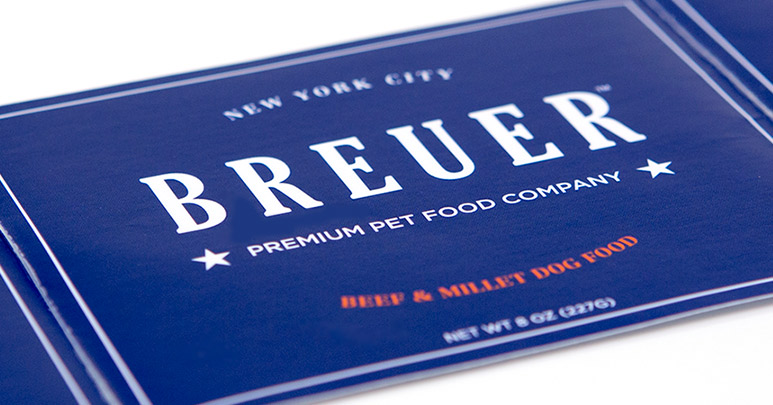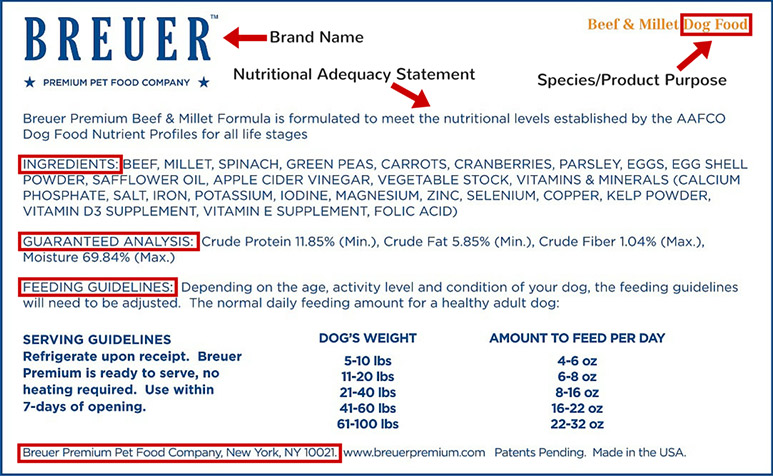
The pet food industry is booming – which isn’t surprising when you consider that an estimated 70-80 million dogs and 74-96 million cats are owned in the United States! Not to mention that global pet food spending represents a roughly US$70 billion industry, with nearly two-thirds of sales taking place in the US and Europe. The demand for pet products is there, and the demand for quality pet food is at the forefront. If you’ve considered taking your pet food to market, now is a great time, but there are some labeling requirements you must follow. Let us point you in the right direction so you can move forward with your pet food labels with confidence.
Pet Food Regulations in the United States
In the United States, pet food is a subset of animal feed and can take different forms. Below is a list of products that are considered “pet food”:
- Complete and balanced foods
- Treats/snacks
- Nutrient supplements (vitamins, minerals, and fatty acids)
- Nutrient-added waters
- Edible chews (rawhide, hooves, bully sticks, and pizzle sticks)
As you can see, there are a variety of opportunities in the pet food market where you can enter or expand. Of course, no matter what pet food product you sell, there are regulations you must follow. Pet food regulation is largely handled by each state, but there are federal regulations as well. Whether you plan on selling your products online, grocery/pet stores, or farmers markets, your pet food products will have to be registered with the state(s) where you’re selling your products.
Each state has their own requirements, forms, and fees. (Yes, selling your products online would legally be considered as distributing your products in every state!) Most states require that you register your products and/or your company before selling in that state. Please visit the Association of American Feed Control Officials (AAFCO) regulatory page to get contact information for states’ feed control officials.
The FDA and AAFCO on Pet Food Labels
On the federal level, the FDA’s Center for Veterinary Medicine (CVM) is responsible for the regulation of animal food products. According to the FDA’s website, pet food products aren’t required to have premarket approval by the FDA. However, the Federal Food, Drug, and Cosmetic Act (FFDCA) requires that pet foods, like human foods, “be pure and wholesome, safe to eat, produced under sanitary conditions, contain no harmful substances, and be truthfully labeled.” Like other products the FDA regulates, the only time you would need premarket approval for your pet food is if you were using new ingredients that aren’t on its “GRAS” list (Generally Recognized as Safe).
Since the FDA works closely with states and AAFCO, we suggest you focus on complying with state laws and AAFCO labeling requirements as these will help you to meet, or even exceed, federal regulations. Please note that AAFCO does not authorize, certify, test, or approve animal feed or pet foods. According to AAFCO’s website, it is “a voluntary membership association of local, state and federal agencies charged by law to regulate the sale and distribution of animal feeds and animal drug remedies.” If you have any questions on pet food labeling, AAFCO’s website and Official Publication are great resources to use.

Basic Labeling Requirements
Before you design and order pet food labels, check out the labeling regulations of any state you plan on selling your products to ensure compliance. Certain states may require extra information on pet food labels, but most follow these basic AAFCO and FDA labeling requirements.
- Brand name and product purpose: Your pet food labels should state your brand’s name and the product’s purpose like whether it’s a treat, supplement, complete food, etc.
- Animal species the product is intended for: On the principal display panel (i.e. the area on the product that consumers will see first), it should be clear what animal species the product is for.
- Net Quantity Statement: This tells the consumer how much contents are in the product. It’s expressed as “net weight” or “net volume,” and must be be stated in the correct units and placed on the lower third of the principal display panel. For net weight or volume, both avoirdupois (pound/ounces) and metric (grams) units must be used.
- Guaranteed Analysis: A “Guaranteed Analysis” lists the percentage of each nutrient in the food product. The minimum percent of crude protein and crude fat, and the maximum percent of crude fiber and crude moisture are always required. “Crude” refers to the analysis method, rather than the quality of the nutrient. Guarantees for other nutrients may be required to support other label claims (such as “High in calcium and vitamin A”). You may also include voluntary guarantees for other nutrients. The guarantees must be given in a particular order, in specified units, and as a minimum or maximum, depending on the nutrient.
- Ingredient Statement: Ingredients must be listed in order of predominance by weight, on an “as formulated basis.” The ingredient that makes up the highest percentage of the product’s total weight is listed first. The ingredients used must be GRAS, approved food additives, or otherwise sanctioned for use in animal feeds. Ingredients must be declared by the correct AAFCO-defined name (where one exists) or the “common or usual” name.
- Nutritional Adequacy Statement: If you identify your product as a complete and balanced food, the claim must be substantiated. The nutritional adequacy statement tells which life stage(s) the product is suitable for, such as: growth, reproduction, adult maintenance, or a combination of these, or intended for intermittent or supplemental feeding only. Products identified on the principal display panel as a snack, treat, or supplement are exempt.
- Feeding directions: All pet foods labeled as “complete and balanced” must include feeding directions that, at a minimum, state “Feed [amount of product] per [weight] of [dog/cat].” Feeding frequency must also be stated. Feeding directions are optional for treats, as long as they are not complete and balanced, and labeled as snacks or treats.
- Manufacturer’s name and address: This names you or your company as guarantor of the product, and gives your location. The street address may be omitted as long as the named entity is listed in the local telephone directory, however, the city, state, and zip code must be shown. If someone else makes the product for you, you must show that relationship by using the words “Manufactured for:” or “Distributed by:” in front of the address.
Like products sold for humans, the information you put on your pet food labels must be truthful and supported by sound scientific or empirical evidence. If you need to get your pet food tested to determine its Guaranteed Analysis, please visit AAFCO’s Testing Laboratories resource page for more information.
Once you have everything squared away with your pet food product (licensing, registration, food analysis, etc.), the next step is to get custom labels that show off your hard work and entice customers. We offer a variety of label products, like cost-effective glossy white labels to eye-catching foils, to fit any style. Get an online quote now or call our customer service team to discuss some label options that will work best with your product, artwork, and brand.


